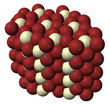| |||
| Names | |||
|---|---|---|---|
| Other names
Neodymium trichloride
| |||
| Identifiers | |||
| |||
3D model (JSmol)
|
|||
| ChemSpider | |||
| ECHA InfoCard | 100.030.016 | ||
PubChem CID
|
|||
| UNII | |||
CompTox Dashboard (EPA)
|
|||
| |||
| |||
| Properties | |||
| NdCl3, NdCl3·6H2O (hydrate) | |||
| Molar mass | 250.598 g/mol | ||
| Appearance | Mauve-colored powder[1] hygroscopic | ||
| Density | 4.13 g/cm3 (2.3 for hydrate)[1] | ||
| Melting point | 759 °C (1,398 °F; 1,032 K)[1] | ||
| Boiling point | 1,600 °C (2,910 °F; 1,870 K)[1] | ||
| 1 kg/L at 25 °C[1] | |||
| Solubility in ethanol | 0.445 kg/L | ||
| Structure[2] | |||
| hexagonal (UCl3 type), hP8 | |||
| P63/m, No. 176 | |||
a = 0.73988 nm, c = 0.42423 nm
| |||
Formula units (Z)
|
2 | ||
| Tricapped trigonal prismatic (nine-coordinate) | |||
| Hazards | |||
| GHS labelling: | |||

| |||
| Warning | |||
| H315, H319, H335 | |||
| P261, P264, P271, P280, P302+P352, P304+P340, P305+P351+P338, P312, P321, P332+P313, P337+P313, P362, P403+P233, P405, P501 | |||
| NFPA 704 (fire diamond) | |||
| Safety data sheet (SDS) | External SDS | ||
| Related compounds | |||
Other anions
|
Neodymium(III) bromide Neodymium(III) oxide | ||
Other cations
|
LaCl3, SmCl3, PrCl3, EuCl3, CeCl3, GdCl3, TbCl3, Promethium(III) chloride | ||
Except where otherwise noted, data are given for materials in their standard state (at 25 °C [77 °F], 100 kPa).
| |||
Neodymium(III) chloride or neodymium trichloride is a chemical compound of neodymium and chlorine with the formula NdCl3. This anhydrous compound is a mauve-colored solid that rapidly absorbs water on exposure to air to form a purple-colored hexahydrate, NdCl3·6H2O. Neodymium(III) chloride is produced from minerals monazite and bastnäsite using a complex multistage extraction process. The chloride has several important applications as an intermediate chemical for production of neodymium metal and neodymium-based lasers and optical fibers. Other applications include a catalyst in organic synthesis and in decomposition of waste water contamination, corrosion protection of aluminium and its alloys, and fluorescent labeling of organic molecules (DNA).
- ^ a b c d e Haynes, William M., ed. (2016). CRC Handbook of Chemistry and Physics (97th ed.). CRC Press. p. 4.75. ISBN 9781498754293.
- ^ Morosin, B. (1968). "Crystal Structures of Anhydrous Rare‐Earth Chlorides". The Journal of Chemical Physics. 49 (7): 3007–3012. Bibcode:1968JChPh..49.3007M. doi:10.1063/1.1670543.


